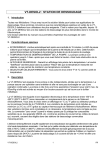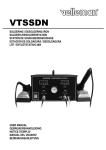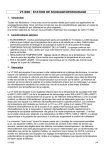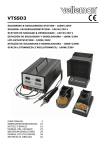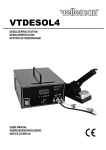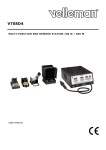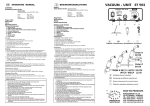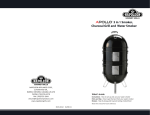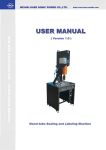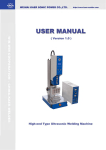Download vt-desol2 : desoldering station
Transcript
VT-DESOL2 DESOLDERING STATION DESOLDEERSTATION STATION DE DESSOUDAGE ENTLÖTSTATION USER MANUAL GEBRUIKERSHANDLEIDING MANUEL D'UTILISATION GEBRAUCHSANLEITUNG VT-DESOL2 : DESOLDERING STATION 1. Introduction Congratulations ! You have selected the ideal solution for all your soldering applications ! We are confident that the versatility of this desoldering station and its many special features will satisfy your every need. It is not surprising, therefore, that the VT-DESOL2 has been one of the electronics industry’s favourite desoldering tools for the last 15 years. We advise you to read this instruction manual carefully. This will enable you to maximise the advantages of your new desoldering station. 2. Special Features • ENERGY SAVER : this new feature will automatically be activated whenever the desoldering station remains unused for more than fifteen minutes. The "Pause" LED will light up, indicating that the temperature of the tip has been reduced by 1/3. This reduces power consumption and extends the life of the tip. • DELAYED SUCTION : This feature allows the pump to continue its suction for 1.5 seconds after the control switch has been released. This eliminates the problem of solder clogging the tip. • DIGITAL DISPLAY : This new feature provides the user with accurate temperature readings. Once the installed temperature has been reached, the "Set/Read" button can be flipped to the "Read" position. This ensures a constant temperature. • CELSIUS/FAHRENHEIT SWITCH : Enables the user to switch from °C to °F and vice versa. 3. Description The VT-DESOL2 is equipped with a self-contained, temperature-controlled vacuum pump. The vacuum pump is maintenance-free. It will not overload with continuous use. The vacuum pump provides a max. suction of 60cm/Hg (23"/Hg) and is activated by a push-button switch located on the iron housing. The VT-DESOL2's electronic circuitry enables you to use tip temperatures ranging from 150°C to 450°C (302°F to 842°F) without having to change the tip or the heating element. The temperature readout can be switched from °C to °F or vice versa simply by flipping a switch on the front panel. The temperature is maintained to within ± 3°C (± 6°F) of the normal operating temperature through a thermocouple sensor located in the heating element. Consequently, even the smallest temperature variations of the tip are monitored and the temperature is rapidly corrected whenever necessary. The revolutionary "zero voltage" switching design also protects voltage- and current-sensitive components (CMOS devices, etc.) against the damaging currents and transient voltage spikes commonly produced by less efficient, mechanically switched desoldering stations. The heating element heats up very quickly and temperature corrections are executed swiftly thanks to the exceptionally high maximum temperature : only one minute is required to reach a temperature of 650 to 750°C (1200 to 1380°F). The heating element is galvanically isolated from the electrical supply by an isolating transformer that prevents the system from using a max. tension higher than a (safe) 24VAC. The desoldering tip has a leakage current of < 0.4mV and a resistance of ≤ 0.5ohm. VT-DESOL2 1 GB This desoldering station is designed to meet the present and future needs of the electronic production industry and is ideally suited for use with any AC outlet. Engineered to meet the stringent demands of hobbyists, maintenance personnel and production people alike, the VTDESOL2 sets a new quality standard for desoldering equipment. 4. Operating Temperature SOLDERING The most common solder alloys used in the electronics industry consist of 60% tin and 40% lead. The operating temperature of this type of solder is detailed below and can vary from manufacturer to manufacturer. Melting point : 215°C Normal operation : 270-320°C Production line operation : 320-380°C or or or 419°F 518-608°F 608-716°F A good joint is assured if the iron's operating temperature is set within the parameters suitable for the type of solder being used. The solder will flow too slowly if the temperature is too low ; if the temperature is too high, the flux in the solder may burn which will give rise to billowing white smoke. In turn, this will result in a dry joint or in permanent damage to the PCB. DESOLDERING Recommended tip temperatures are detailed below. They can vary from joint to joint. For a small joint : 320-360°C or 608-680°F For a larger joint : 370-400°C or 698-752°F If the temperature is too low, the solder will flow too slowly and this may cause the tip to clog ; you may burn the PCB if the temperature is too high. 5. Operating Instructions Verify whether the operating voltage of the unit is identical to that of the electrical supply. Make sure the device was not damaged in transit. OPERATING PROCEDURE FOR DESOLDERING ACTIVITIES (a) Plug in the desoldering iron and connect the vacuum tube to the DIA-connections on the front panel. (b) Connect the AC power cord to the mains inlet. (c) Place the temperature control knob in the "MIN"-position. (d) Place the power switch in the "ON"-position. The pilot lamp will light up. (e) Set the temperature control knob to 250°C (482°F). Tin the surface of the nozzle of the desoldering tip by applying a new protective layer of solder. (f) Set the temperature control knob to the desired temperature 3 minutes after the station has reached a temperature of 250°C (482°F). The unit is ready for use when it reaches the preset temperature : the pilot light will extinguish at this time. NOTE : The energy-saving feature will automatically engage if the desoldering station remains inactive for more than 15 minutes (indicated by the green "PAUSE" indicator light). The VT-DESOL2 2 GB temperature will be reduced by 1/3, which prolongs the life of the tip. Activate the red button on the handle in order to disengage the power-saving feature. The temperature will now be increased until the preset temperature is reached. DESOLDERING : IMPORTANT NOTES (a) Do not activate the vacuum pump until the solder has melted completely. Melting is achieved by moving the hot tip around the lead, leaving visibly melted solder on the component side of the PCB. (b) Release the vacuum switch when the tip is completely solder-free, otherwise the tip may clog. (c) Add solder to the joint of the component and allow the solder to melt completely for improved desoldering. (d) Remove the solder collector and clean it after no more than 200 applications. However, daily cleaning is strongly recommended, especially if the device is used on a daily basis. (e) Replace the cotton pad in the solder collector and the in-line filter when they start to turn yellow. (f) Use the included spring wire to clean the tip in case of insufficient suction. Also check the in-line filters. (g) Make sure that all filters are in place during operation in order to avoid damage to the vacuum pump. (h) Read "OPERATING PROCEDURE FOR DESOLDERING ACTIVITIES" when you wish to replace the tip. 6. Common Causes for Tip Failure - The temperature of the tip exceeds 410°C (770°F) The tip is not sufficiently tinned Wiping the tip on a surface with a high sulphur content or on a dirty or dry sponge Contact with organic or chemical substances such as plastic, resin, silicone and grease Impurities in the solder and/or a low tin content 7. Maintenance Tips for Tips The desoldering iron uses extremely high temperatures. Make sure that the unit is switched off for maintenance purposes. Remove the tip and clean it after heavy or moderate use. We recommend cleaning the tip daily if the desoldering station is used on a daily basis. Remove excess solder in the tip retaining assembly to prevent the tip from clogging. The supplied desoldering tips are made of copper covered with a layer of iron. They will retain their projected life span if used properly. - Always tin the tip before returning it to the holder, prior to turning off the station or to storing it for long periods of time. Wipe the tip on a wet sponge or use our tip cleaner (ref. VTSTC) before activating the device. - Using excessive temperatures (more than 400°C or 750°F) will shorten the life span of the tip. - Do not exercise excessive pressure on the tip while desoldering, as this may cause damage to the tip. - Never clean the tip with a file or with abrasive materials. - Do not use flux containing chloride or acid. Use only resinous fluxes. - If an oxide film has formed, you should remove it by buffing carefully with a 600-800 grit emery cloth or by using isopropyl alcohol and consequently applying a new protective layer of solder. VT-DESOL2 3 GB - Set the temperature control knob to the minimum position and place the main power switch in the "ON"-position. - Set the temperature for 250°C (482°F). - Coat the tinned surfaces with a layer of solder. - Install the desired temperature after allowing the unit to idle at 250°C for three minutes. - The station will be ready for use once the installed temperature is reached. 8. Loss of Suction : Possible Causes Use the procedure outlined below to determine whether the loss of suction is due to the tip, to the solder collector, the tube or the in-line filters. CAUTION : THE MAIN POWER SWITCH SHOULD BE IN THE "OFF"-POSITION BEFORE ATTEMPTING THESE PROCEDURES. THIS WILL ALLOW THE DEVICE TO COOL. a) disconnect the vacuum tube from the fitting on the front panel. Place your finger over the hole and depress the vacuum switch. You should now have a strong vacuum. If not : return the station to the point of sale to have the pump repaired. b) disconnect the in-line filters from the iron assembly. Depress the vacuum switch, replace the filling of the in-line filters if there is little suction or if the filters are discoloured. c) Remove the solder collector from the desoldering iron assembly, place your finger over the hole and depress the vacuum switch. Clean or replace the collector tube in case of insufficient suction. d) Depress the vacuum switch and clean the tip with the included spring wire if there is no suction. Read "10. Cleaning Procedure for Clogged Tips". 9. Maintenance Desoldering tips can be replaced simply by unscrewing the barrel nut assembly. Turn off the station and allow it to cool first. Damage to the soldering station may occur if the system is left on and the removed tip has not been replaced. After removing the tip, you should blow out any oxide dust that may have formed in the tip receptacle. Be careful not to get dust in your eyes. Replace the tip and tighten the screw. Pliers can be used to avoid contact with hot surfaces BUT SHOULD BE USED WITH CAUTION because overtightening may cause damage to the element or fuse the tip to the element. 10. Cleaning Procedure for Clogged Tips CAUTION : BE VERY CAREFUL NOT TO BURN YOUR FINGERS WHEN CLEANING THE TIP. 1. Move the spring wire (included) back and forth in order to clean the tip. 2. Raise the temperature of the heating element to allow the clogged solder to melt. Clean the tip by sliding the spring wire up and down until the passage is clear (see fig. 1) 3. Unscrew the barrel nut assembly (fig. 2 & 3). 4. Use a pair of pliers to remove the tip (fig. 4 & 5). 5. Reinsert the stainless tube in the heating element to melt the solder, as shown in fig. 6. This will take approximately 5 seconds. 6. Remove the stainless tube and shake loose the molten solder. The tip should now be unclogged (fig. 7). Put the tip back in place and screw down the barrel nut assembly. Do not screw it down too tightly ! VT-DESOL2 4 GB FIG. 1 FIG. 2 FIG. 4 FIG. 5 FIG. 3 FIG. 6 FIG. 7 11. Procedure for Cleaning the Solder Collector CAUTION : Put the main power switch in the "OFF"-position and allow the iron to cool first. 1. Hold the iron as shown in fig. 8. Press and turn the knob at the butt of the iron. 2. Be careful not to burn your fingers on the glass solder collector as you slide it free (see fig. 9). 3. Point the collector towards the ground (see fig. 10) while shaking lightly to free the excess solder. Do this frequently to keep the station in proper working order. 4. Remove the cooling strip with a pair of pliers (fig. 11 & 12). 5. Clean the cooling strip and the glass collector with a wire brush (included). FIG. 8 VT-DESOL2 FIG. 9 FIG. 10 5 GB FIG. 11 FIG. 12 12. Replacement of Filters a. FILTER OF THE SOLDER COLLECTOR 1. 2. 3. 4. 5. Make sure that the iron and the filter have cooled sufficiently. Point the iron slightly upwards while pressing and turning the red knob on the butt of the iron. Remove the solder collector (fig. 9). Disassemble the solder collector (fig. 13 & 14). Remove the old filter and replace it with a new one (fig. 15 & 16). FIG. 13 FIG. 14 FIG. 15 FIG. 16 b. IN-LINE FILTERS 1. Unscrew the in-line filters and pull the two pieces apart (fig. 17 & 18). FIG. 17 VT-DESOL2 6 GB 2. Replace the fillings of both filters as shown in fig. 18. FIG. 18 fillings TO STATION TO IRON BITDEST2 Note : Use a desoldering tip with a Ø of 1.2mm (BITDEST2). VT-DESOL2 7 GB









